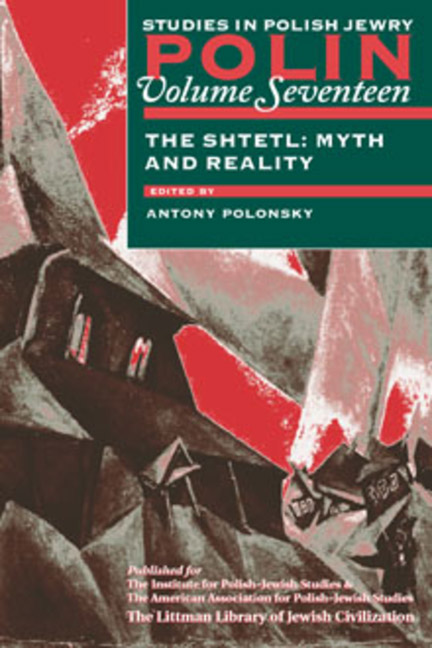Book contents
- Frontmatter
- Dedication
- Editors and Advisers
- Preface
- Polin
- Polin: Studies inPolish Jewry
- Contents
- Note on Place Names
- Note on Transliteration
- List of Abbreviations
- PART I THE SHTETL: MYTH AND REALITY
- Introduction. The Shtetl: Myth and Reality
- The Shtetl as an Arena for Polish–Jewish Integration in the Eighteenth Century
- Inter-Religious Contacts in the Shtetl: Proposals for Future Research
- The Hasidic Conquest of Small-Town Central Poland, 1754–1818
- The Drama of Berdichev: Levi Yitshak and his Town
- Polish Shtetls under Russian Rule, 1772–1914
- How Jewish Was the Shtetl?
- The Changing Shtetl in the Kingdom of Poland during the First World War
- The Shtetl: Cultural Evolution in Small Jewish Towns
- Small Towns in Inter-War Poland
- Jewish Patrons and Polish Clients: Patronage in a Small Galician Town
- Maintaining Borders, Crossing Borders: Social Relationships in the Shtetl
- The Soviet Shtetl in the 1920s
- Shtetl and Shtot in Yiddish Haskalah Drama
- Kazimierz on the Vistula: Polish Literary Portrayals of the Shtetl
- Imagining the Image: Interpretations of the Shtetl in Yiddish Literary Criticism
- Shtetl Codes: Fantasy in the Fiction of Asch, Schulz, and I. B. Singer
- Returning to the Shtetl: Differing Perceptions
- PART II NEW VIEWS
- PART III DOCUMENTS
- PART IV THE SIXTY-FIFTH ANNIVERSARY OF EVENTS IN PRZYTYK: A DEBATE
- PART V REVIEWS
- OBITUARIES
- Notes on the Contributors
- Glossary
- Index
Shtetl Codes: Fantasy in the Fiction of Asch, Schulz, and I. B. Singer
from PART I - THE SHTETL: MYTH AND REALITY
- Frontmatter
- Dedication
- Editors and Advisers
- Preface
- Polin
- Polin: Studies inPolish Jewry
- Contents
- Note on Place Names
- Note on Transliteration
- List of Abbreviations
- PART I THE SHTETL: MYTH AND REALITY
- Introduction. The Shtetl: Myth and Reality
- The Shtetl as an Arena for Polish–Jewish Integration in the Eighteenth Century
- Inter-Religious Contacts in the Shtetl: Proposals for Future Research
- The Hasidic Conquest of Small-Town Central Poland, 1754–1818
- The Drama of Berdichev: Levi Yitshak and his Town
- Polish Shtetls under Russian Rule, 1772–1914
- How Jewish Was the Shtetl?
- The Changing Shtetl in the Kingdom of Poland during the First World War
- The Shtetl: Cultural Evolution in Small Jewish Towns
- Small Towns in Inter-War Poland
- Jewish Patrons and Polish Clients: Patronage in a Small Galician Town
- Maintaining Borders, Crossing Borders: Social Relationships in the Shtetl
- The Soviet Shtetl in the 1920s
- Shtetl and Shtot in Yiddish Haskalah Drama
- Kazimierz on the Vistula: Polish Literary Portrayals of the Shtetl
- Imagining the Image: Interpretations of the Shtetl in Yiddish Literary Criticism
- Shtetl Codes: Fantasy in the Fiction of Asch, Schulz, and I. B. Singer
- Returning to the Shtetl: Differing Perceptions
- PART II NEW VIEWS
- PART III DOCUMENTS
- PART IV THE SIXTY-FIFTH ANNIVERSARY OF EVENTS IN PRZYTYK: A DEBATE
- PART V REVIEWS
- OBITUARIES
- Notes on the Contributors
- Glossary
- Index
Summary
THE east European shtetl has entered the world's literature as a symbolic space associated with a specific culture and with specific ideas, traditions, customs, characteristic heroes, and topography. It has assumed the status of a myth rooted in writers’ experiences and memories. As David Roskies notes, ‘The shtetl … is arguably the greatest single invention of Yiddish literature. What the Western is to American popular culture, the shtetl novella is to the Jewish imagination.’ As an archetypal literary image, the shtetl theme often encompasses the sphere of fantasy and fairy tale, reshaping the historical image of this place and its people in accordance with the writer's main artistic aims. This is precisely the case in the works of Sholem Asch, Isaac Bashevis Singer, and Bruno Schulz: the element of the fantastic assumes a great variety of forms and fulfils diverse functions.
The role of fantasy and fairy tale in literature is at least twofold: it can serve to paraphrase reality, revealing those parts of it that are hidden beyond the reach of reason; alternatively, it can fulfil the magical function of modifying the real world and enriching it with the qualities the author seeks. Whatever the case may be, fantastic elements modifying the image of the shtetl and its community remove the shtetl motif from a mere sociological or historical context and redirect the reader's attention to the themes and ideas it symbolizes.
For Asch and Schulz, the magical function of the fantastic in the shtetl image is the most important, though it has different sources and is demonstrated in different ways. Singer, on the other hand, uses fairy tale and fantasy to highlight certain truths about man's nature and to supplement the realistic sphere of existence presented in his works. The heroes and background of the shtetl merely place those ideas in a specific ethnic context and lend credence to the stories in accordance with Singer's dictum, ‘The more a writer is rooted in his environment, the more he is understood by all people.’ The explicit implementation of fantasy in the artistic works of each of the three writers provokes some questions: What messages are conveyed by means of fantasy in each case?
- Type
- Chapter
- Information
- The Shtetl: Myth and Reality , pp. 259 - 266Publisher: Liverpool University PressPrint publication year: 2004

